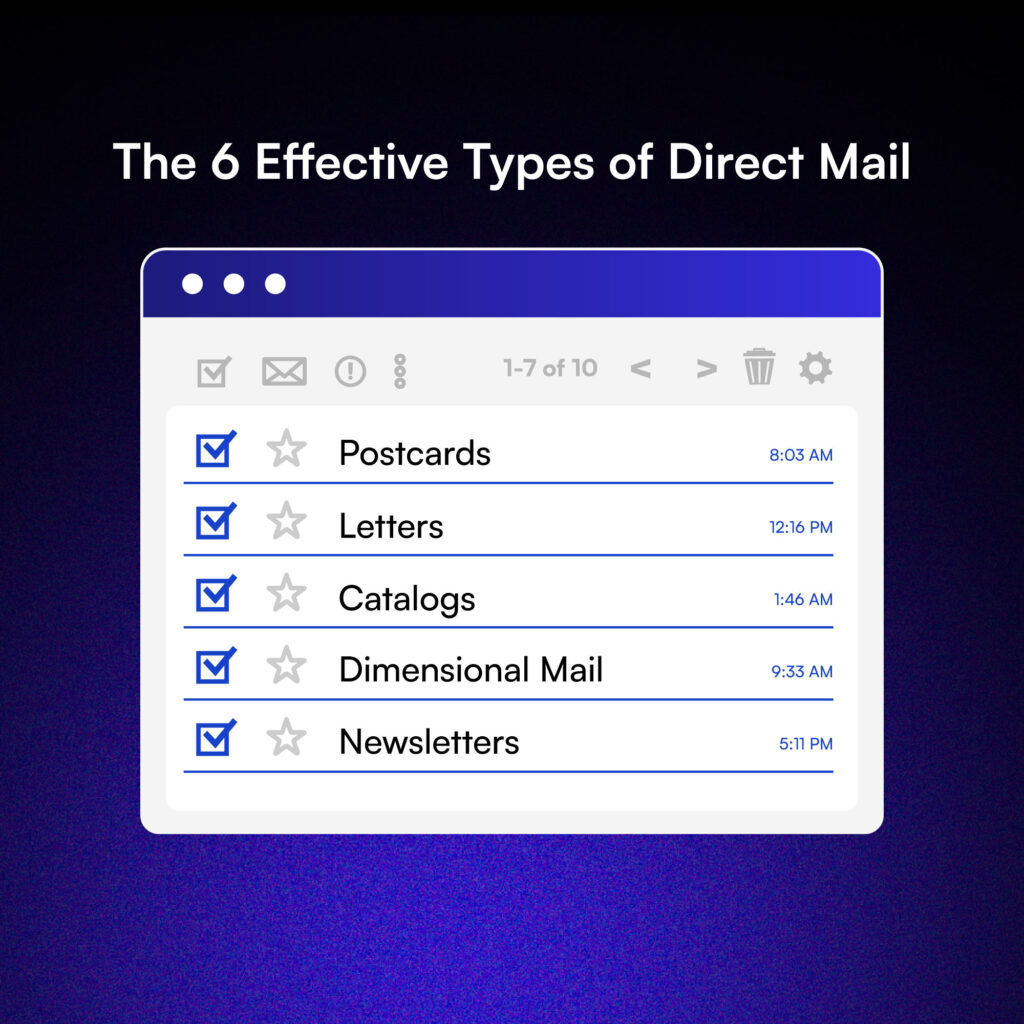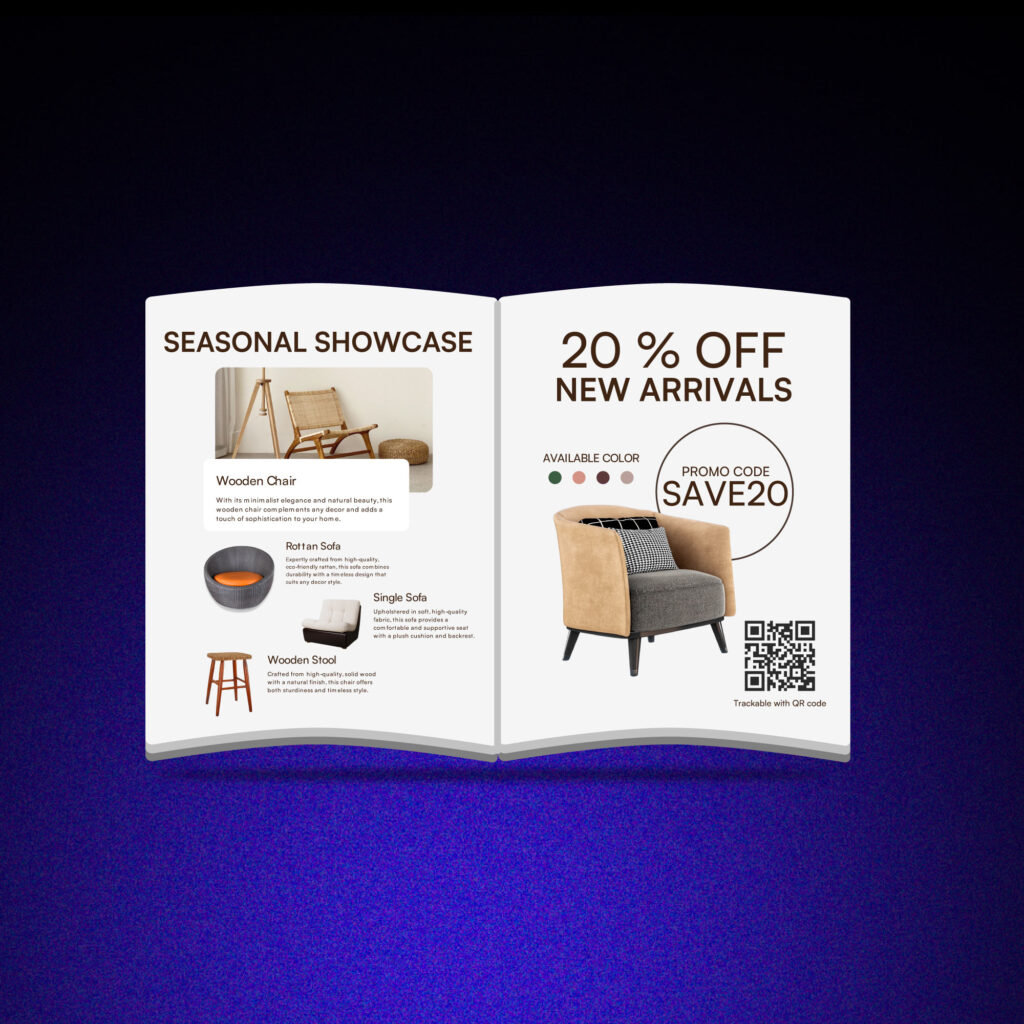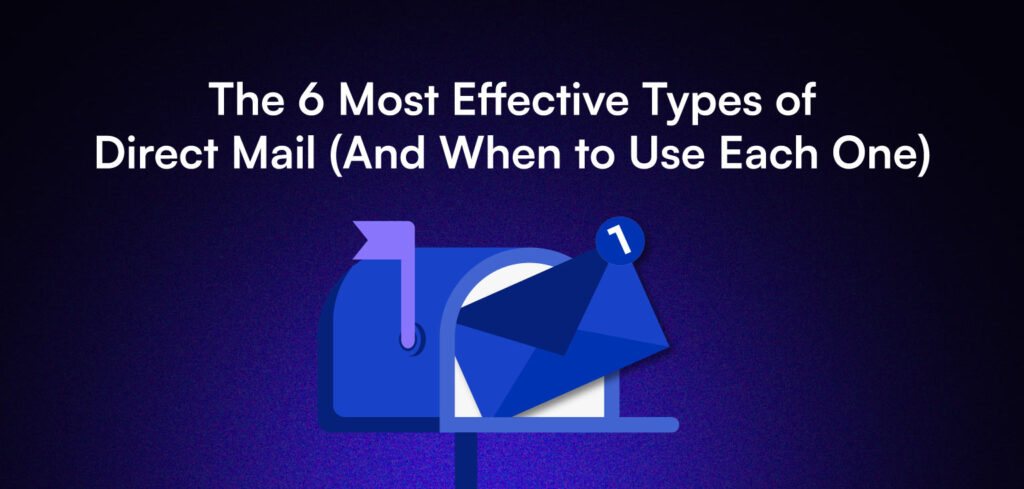Direct mail might sound old school, but in a world overflowing with digital noise, it’s quietly making a serious comeback, and for good reason. It cuts through clutter, lands right in your audience’s hands, and, when done right, delivers real results.
But here’s the thing: Not all direct mail is created equal. Some formats are perfect for grabbing quick attention, while others are better suited for nurturing long-term relationships or driving targeted responses.
Whether you’re building a local campaign, re-engaging past customers, or launching something brand new, knowing which types of direct mail to use (and when) can make all the difference.
So, in this guide, we’ll break down the six most effective types of direct mail, why they work, and how to use them strategically. Let’s dive in and help your next campaign hit the mark.
The 6 Types of Direct Mail

1. Postcards — Best for Quick Promotions and Strong CTAs
Postcards are the minimalist powerhouse of the types of direct mail. They’re quick to produce, inexpensive to send, and don’t hide behind an envelope, meaning your message gets seen the moment it hits the mailbox.
What makes postcards so effective is their simplicity. There’s no fluff, no long paragraphs, just bold visuals, a clear headline, and a strong call to action. Perfect for flash sales, limited-time discounts, or event invites that need to grab attention fast.
They’re especially effective for businesses that want to drive immediate action without overwhelming the recipient. Think restaurant promos, grand openings, seasonal sales, or service discounts.
What it is:
A simple, single-sheet mailer that delivers your message upfront, with no need to open anything.
When to use it:
Ideal for flash sales, event promotions, new product launches, and any campaign with a short shelf life.
Why it works:
No envelope means no extra step. It’s cost-effective, quick to read, and hard to miss.
Example:
“We’re celebrating our anniversary. Enjoy 25% off your next visit. Just show this postcard at checkout!”
Pro tip:
Go oversized. A larger postcard literally rises above the rest in the stack and gives you more space to sell without paying envelope-level costs.
2. Letters — Best for Personalization and Formal Messaging
If postcards are your loud extroverts, letters are the thoughtful introverts out of all the types of direct mail. They arrive in envelopes, require a little unwrapping, and carry a more personal tone, especially when tailored to the reader.
Letters work brilliantly for formal or sensitive communications like B2B outreach, donation requests, or anything involving customer trust and confidentiality. They’re a great way to build credibility, share a message in more detail, or deliver news that warrants a bit more weight.
And when you pair a well-written letter with personalized fields (like name, company, or location), it feels less like marketing and more like it was written just for them.
What it is:
A traditional letter format, printed and mailed inside an envelope, often with a custom salutation.
When to use it:
Best for B2B communication, nonprofit fundraising, account updates, or private offers.
Why it works:
It creates a sense of trust and importance, especially when personalized and signed.
Example:
“We wanted to personally thank you for your continued support and offer you early access to our new service package.”
Pro tip:
Use a handwritten-style font for the signature and a real name to increase authenticity and response rates.
3. Catalogs — Best for Product Showcases and Seasonal Promotions

Catalogs are the heavyweight champions of direct mail. Multi-page, glossy, and packed with visuals, they let you showcase a full lineup of products while inspiring customers to browse at their own pace.
They’re ideal for businesses with a wide range of SKUs or rotating seasonal collections; think fashion brands, furniture stores, or beauty retailers. The tactile experience of flipping through pages creates a deeper engagement than digital browsing.
Plus, with smart layout design and cross-channel tracking tools like QR codes or custom promo codes, you can drive both online and in-store purchases with ease.
What it is:
A bound or folded multi-page mailer that highlights multiple products or collections.
When to use it:
Great for seasonal drops, holiday campaigns, product launches, and annual mailers.
Why it works:
Keeps readers engaged longer, encourages browsing, and creates a more immersive brand experience.
Example:
“Flip to page 10 for exclusive holiday sets, only available through this catalog.”
Pro tip:
Include QR codes or discount codes to track how many readers actually converted.
4. Self-Mailers — Best for Brand Awareness and Visual Storytelling
Self-mailers are the sleek middle ground between a postcard and a brochure. No envelope is needed, just a folded piece of mail that opens up to reveal your message inside. They’re lightweight, visually driven, and surprisingly versatile.
These are great for businesses that want to introduce their brand, showcase a service, or tell a quick story, all in one neat, compact piece. Think of them as a mini-magazine that gives just enough detail to hook someone in without overwhelming them.
With the right design, self-mailers guide the reader from headline to CTA as a good landing page would. Add bold visuals, snappy copy, and a clear next step, and you’ve got yourself a scroll-free engagement tool.
What it is:
A folded direct mail piece (usually bi- or tri-fold) sent without an envelope.
When to use it:
Perfect for brand introductions, service menus, short storytelling, or limited-time bundles.
Why it works:
Highly visual, easy to skim, and designed for quick takeaways and responses.
Example:
“Unfold your next adventure, save 20% on local getaways inside.”
Pro tip:
Place a strong hook or teaser on the front panel to make them want to open it.
5. Dimensional Mail — Best for High-Value Prospects and Gifting Campaigns
If you’re trying to impress or win over a high-value customer, dimensional mail is your golden ticket. We’re talking boxes, tubes, padded envelopes, anything with physical depth that stands out from the rest of the day’s mail.
Dimensional mail is ideal for account-based marketing (ABM), corporate gifting, or VIP customer campaigns. The tactile, often surprising nature of the format creates a “wow” moment that’s hard to ignore and even harder to throw away.
It’s pricier than the rest of types of direct mail formats, but when used strategically, it delivers serious ROI.
What it is:
Any direct mail piece with dimension; think boxes, kits, or thick packages that create a premium experience.
When to use it:
Great for B2B ABM campaigns, product samples, or exclusive gifts for top-tier customers.
Why it works:
Highly engaging, harder to discard, and often shared with others (hello, word of mouth).
Example:
“Open for a surprise! This gift’s just for our most loyal customers.”
Pro tip:
Invest in quality packaging and branding for a strong unboxing experience that reflects your brand’s value.
6. Newsletters — Best for Education and Ongoing Engagement
Design a single printed newsletter page. Include sections like a tips column, a customer spotlight, and a short brand update. Add small labels like “Educational content,” “Recurring format,” and “Builds customer loyalty.”
Printed newsletters might sound retro, but they’re still a solid move for brands that want to build long-term trust. Unlike promotional flyers, newsletters focus on delivering useful, relevant content (e.g. how-tos, tips, updates, and community stories).
They work especially well for nonprofits, local service businesses, schools, and loyalty-based brands. When your content informs or inspires, people actually look forward to receiving it.
A consistent newsletter helps you stay top of mind, position your brand as an expert, and deepen relationships without always selling.
What it is:
A printed publication with recurring updates, stories, or tips sent monthly or quarterly.
When to use it:
Best for brand nurturing, community engagement, and value-driven marketing.
Why it works:
Keeps your audience informed and engaged while reinforcing your brand message over time.
Example:
“This month in your inbox: seasonal garden tips, behind-the-scenes stories, and a customer spotlight.”
Pro tip:
Pair print newsletters with digital follow-ups for a cohesive multi-channel strategy.
Final Thoughts
Choosing the right types of direct mail can make or break your campaign. Postcards are perfect for time-sensitive promos, while letters add a personal, formal touch. Catalogs let your products shine, self-mailers keep things visually engaging, and dimensional mail delivers that wow factor for high-stakes outreach. Newsletters? They’re slow-burn loyalty builders.
The most effective marketers match the format to the message. When you understand the strengths of each type of direct mail, your strategy becomes sharper, more innovative, and far more impactful.


